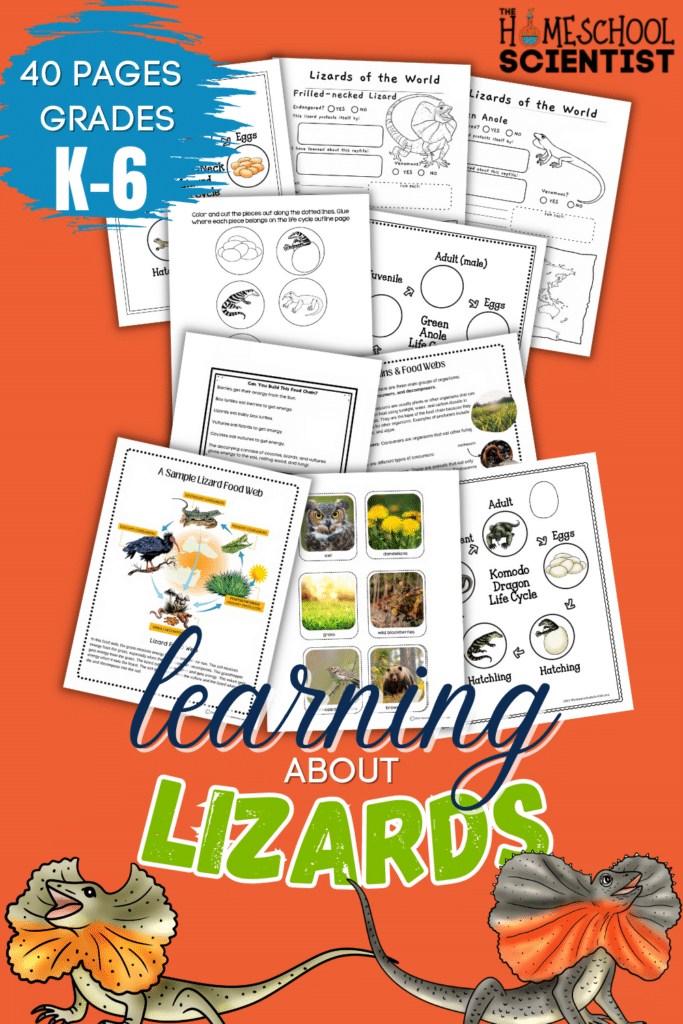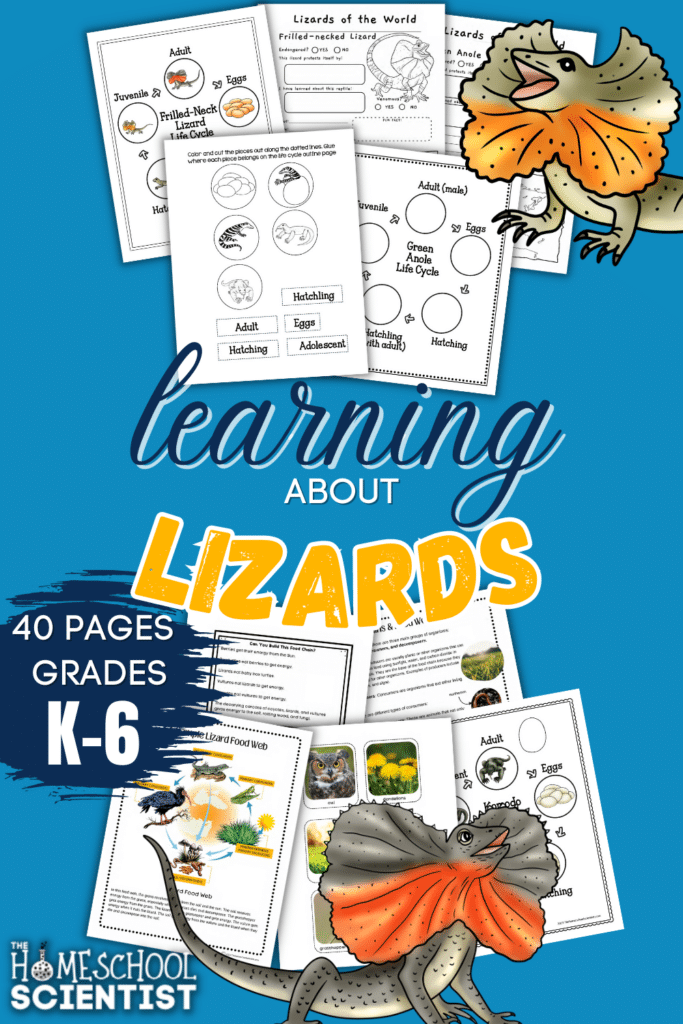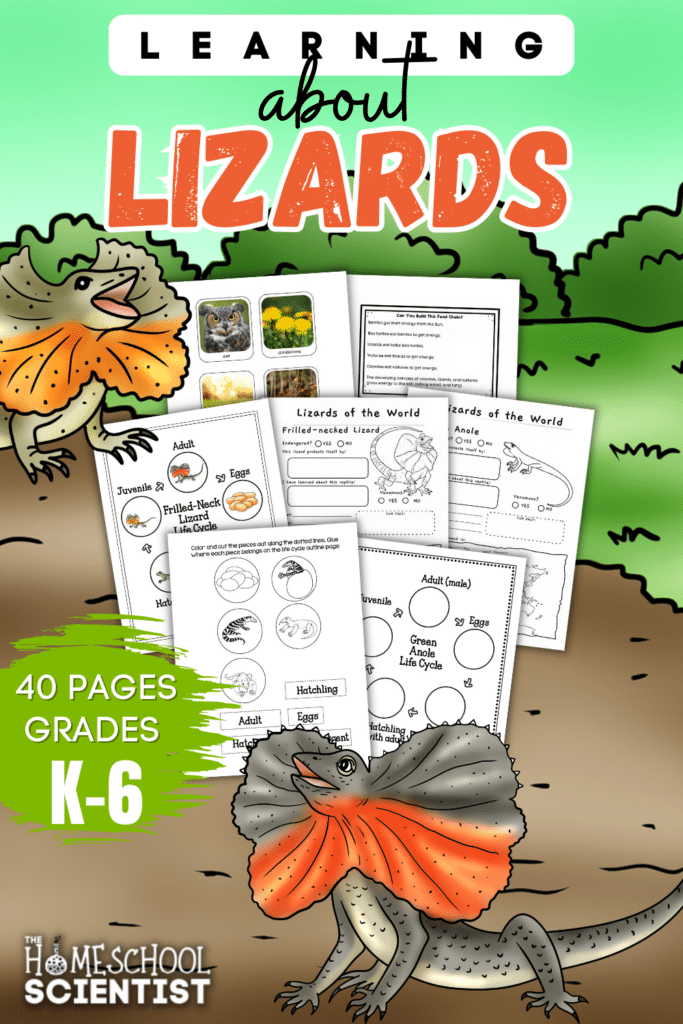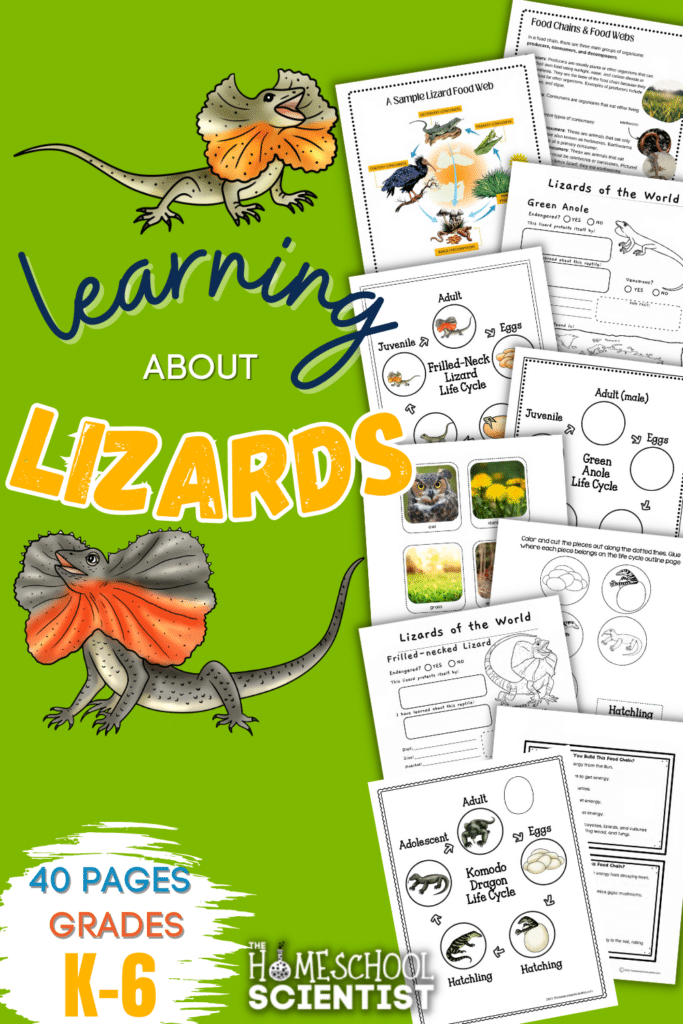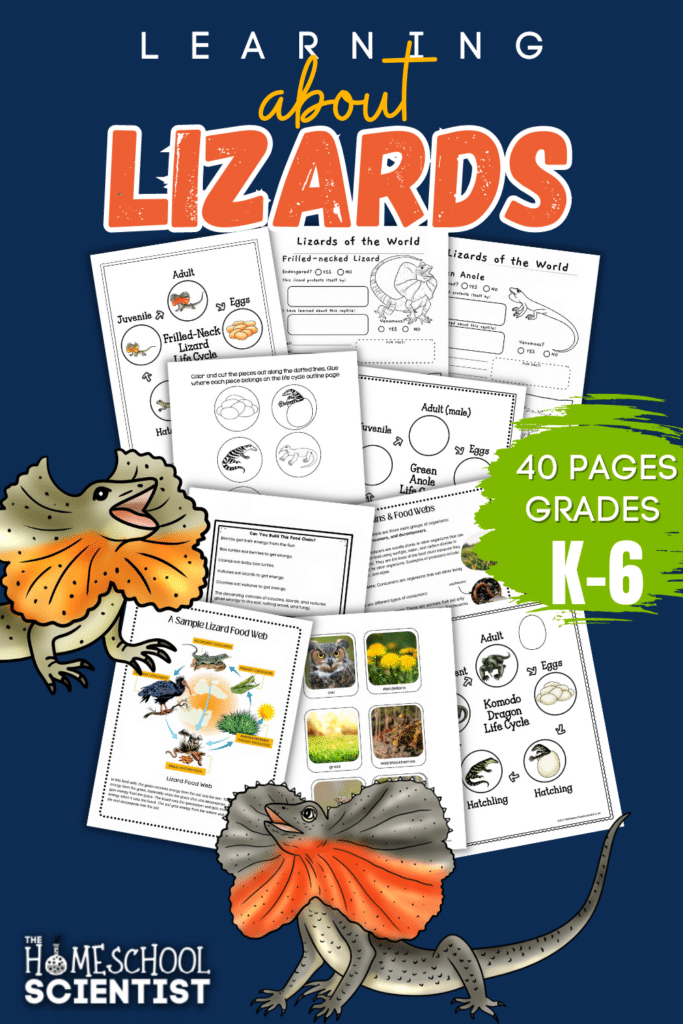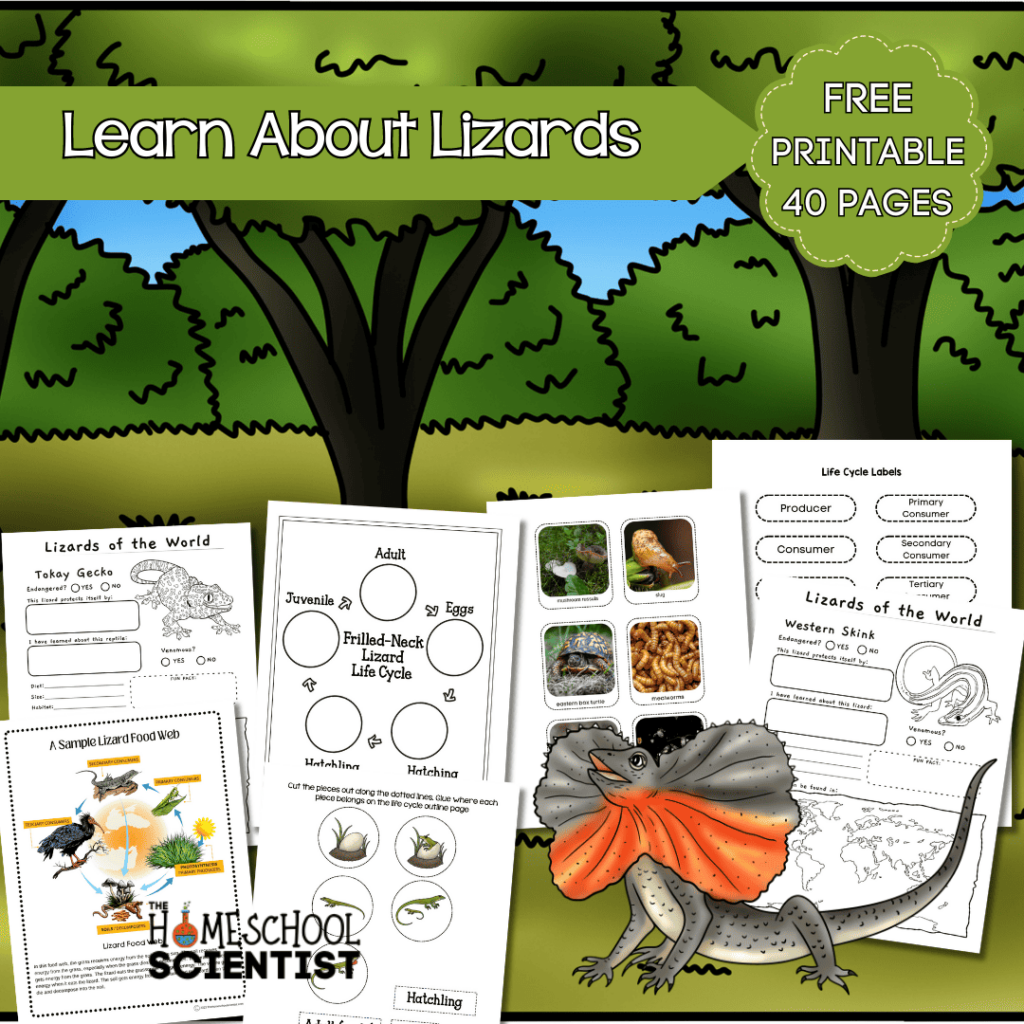28 Reptile Facts and a FREE Lizard Printable
28 Fun Reptile & Lizard Facts
- Reptiles are cold-blooded vertebrates, meaning they rely on external sources of heat to regulate their body temperature.
- Lizards belong to the reptile group known as Squamata, which also includes snakes and amphisbaenians (worm lizards).
- Reptiles have scales made of keratin, which provides protection and helps prevent water loss.
- The largest reptile is the saltwater crocodile, which can grow up to 23 feet (7 meters) in length and weigh over 2,000 pounds (900 kilograms).
- The smallest reptile is the Brookesia micra, a chameleon species found in Madagascar, measuring only about 1 inch (2.5 centimeters) in length.
- Some reptiles, like snakes and lizards, can shed and replace their skin periodically.
- Lizards are found on every continent except Antarctica. They thrive in a wide range of habitats, from deserts to rainforests and from grasslands to rocky outcrops.
- They have a unique ability to regenerate lost limbs. If a predator captures a lizard by its tail, it can detach the tail as a defense mechanism. The lost tail will then regrow over time.
- The largest lizard is the Komodo dragon (Varanus komodoensis), native to Indonesia. It can grow up to 10 feet (3 meters) in length and weigh over 150 pounds (70 kilograms).
- Many lizards are capable of changing color, which helps them regulate their body temperature and communicate with other lizards.
- Reptiles lay eggs with a leathery or calcified shell, and they are the first animals to have evolved this reproductive strategy.
- Turtles are among the oldest living reptiles and have remained relatively unchanged in appearance for millions of years.
- Komodo dragons are the largest living lizards and are native to the Indonesian islands.
- The tuatara, native to New Zealand, is not a lizard but the last surviving member of a distinct reptile group.
- The chameleon is famous for its ability to change color, but contrary to popular belief, they don’t change color to match their surroundings. Instead, they change color in response to emotions, temperature, and social signals.
- Reptiles play a vital role in ecosystems by controlling populations of insects and small animals.
- Many species of snakes are non-venomous and use constriction to subdue their prey.
- Some reptiles, like the spiny-tailed iguana, are capable of reproducing through parthenogenesis, which means they can lay fertile eggs without mating.
- The sex of some reptiles, such as certain turtles, is determined by the temperature during incubation. Warmer temperatures usually result in females, while cooler temperatures produce males.
- Some lizards, like the gecko, have specialized toe pads covered in microscopic hairs called setae, which allow them to climb vertical surfaces and even walk upside down on ceilings.
- The Gila monster and the Mexican beaded lizard are the only venomous lizards. They have venom glands in their lower jaws and deliver venom through grooves in their teeth.
- Lizards have excellent eyesight and can see in color. Many species also have a specialized third eye, called a parietal eye, on the top of their heads, which helps detect light and shadows.
- Lizards are ectothermic, meaning they rely on external sources of heat to regulate their body temperature. They bask in the sun to warm up and seek shade or burrows to cool down.
- Reptiles can slow down their metabolism and go into a state of dormancy, known as brumation or aestivation, during extreme environmental conditions.
- Some species of snakes, like the black mamba and king cobra, are highly venomous and possess potent neurotoxic venom.
- The gharial, a critically endangered crocodile species, has a thin elongated snout perfectly adapted for catching fish.
- Many reptiles have impressive longevity; for instance, Aldabra giant tortoises have been known to live over 100 years.
- Tail Autotomy: Many lizards can detach their tails as a defense mechanism to escape from predators. The detached tail will continue to wiggle, distracting the predator and giving the lizard a chance to escape. The regrown tail might be slightly different in appearance compared to the original one.
Lizards display incredible diversity in their appearance, behavior, and adaptations. Their unique features and wide distribution make them a fascinating group of animals to study and appreciate.
Types of Lizards
There are 7,000 species of lizards in the world. These are put into one of two main groups:
- Iguania (Iguanians): Iguanians are the larger and more diverse group of lizards. They are characterized by their flexible and mobile jaw structure, which allows them to be omnivorous or herbivorous. Iguanians often have a dewlap (a flap of skin under their throat) used for communication and display. This group includes well-known lizards like iguanas, chameleons, anoles, and agamids.
- Scleroglossa (Scleroglossans): Scleroglossans are a more inclusive group of lizards that includes all lizards except the Iguania. They have a stiffer, more rigid jaw structure, which often makes them primarily carnivorous. The group comprises a wide variety of lizards, including geckos, skinks, monitor lizards, and many others.
30 Types of Lizards
Here are 30 types of lizards from various families and regions:
- Green Iguana (Iguana iguana)
- Frilled Lizard (Chlamydosaurus kingii)
- Komodo Dragon (Varanus komodoensis)
- Veiled Chameleon (Chamaeleo calyptratus)
- Leopard Gecko (Eublepharis macularius)
- Gila Monster (Heloderma suspectum)
- Jackson’s Chameleon (Trioceros jacksonii)
- Blue-tongued Skink (Tiliqua spp.)
- Bearded Dragon (Pogona spp.)
- Anole (Anolis spp.)
- Monitor Lizard (Varanus spp.)
- Collared Lizard (Crotaphytus collaris)
- Crested Gecko (Correlophus ciliatus)
- Argentine Black and White Tegu (Salvator merianae)
- Uromastyx (Uromastyx spp.)
- Horned Lizard (Phrynosoma spp.)
- Green Basilisk (Basiliscus plumifrons)
- Ameiva (Ameiva spp.)
- Tokay Gecko (Gekko gecko)
- Fence Lizard (Sceloporus spp.)
- Panther Chameleon (Furcifer pardalis)
- Skunk Gecko (Lygodactylus luteopicturatus)
- Asian Water Monitor (Varanus salvator)
- Solomon Island Prehensile-tailed Skink (Corucia zebrata)
- Mediterranean House Gecko (Hemidactylus turcicus)
- Crested Anole (Norops cristatellus)
- African Rock Python (Python sebae) – a large snake that preys on lizards
- New Caledonian Giant Gecko (Rhacodactylus leachianus)
- Beaded Lizard (Heloderma horridum)
- European Green Lizard (Lacerta viridis)
This list includes a diverse selection of lizards, showcasing the range of shapes, sizes, and habitats that these fascinating reptiles inhabit. It’s important to note that there are many more species of lizards found worldwide, and this list represents only a small fraction of the diverse lizards on Earth.
Lizard Study Resources & a Free Printable
The first resource we want to share is a 40-page lizard printable pack for elementary grades, although your middle school child might enjoy the research pages.
- Video – This is amazing! Chameleon changing colors
- How Do Chameleons Change Colors?
- Reptiles from National Geographic Zoo
- Lizard information from the San Diego Zoo
- Lizard Aerobics Lesson from Arizona Game & Fish
- Amphibian and Lizard Conservation
- What Do Lizards Eat from BioDiversity
- Lizards in New Zealand
- Differences Between Salamanders and Lizards from Purdue Univeristy
- Video: 15 Most Beautiful Iguanas in the World
I hold a master’s degree in child development and early education and am working on a post-baccalaureate in biology. I spent 15 years working for a biotechnology company developing IT systems in DNA testing laboratories across the US. I taught K4 in a private school, homeschooled my children, and have taught on the mission field in southern Asia. For 4 years, I served on our state’s FIRST Lego League tournament Board and served as the Judging Director. I own thehomeschoolscientist and also write a regular science column for Homeschooling Today Magazine. You’ll also find my writings on the CTCMath blog. Through this site, I have authored over 50 math and science resources.



